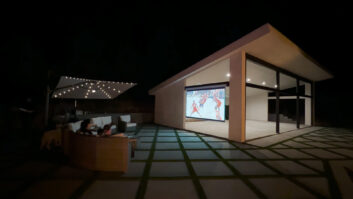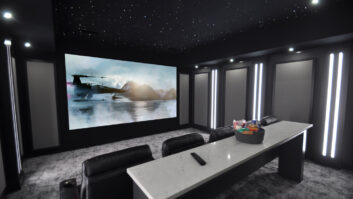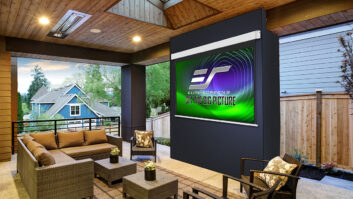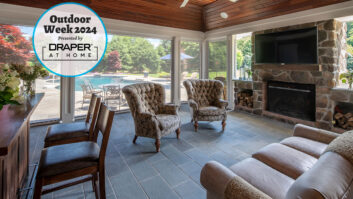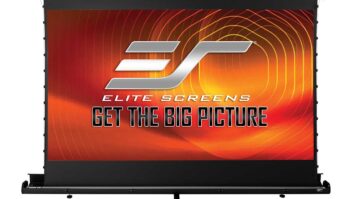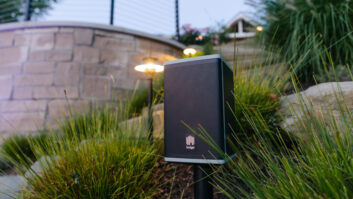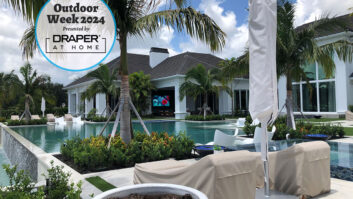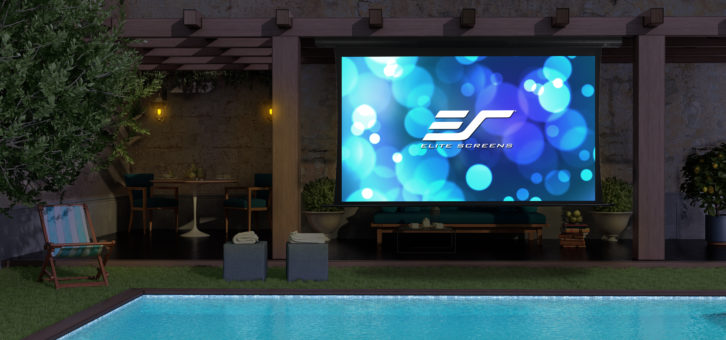
As we approach summertime, many people start thinking about outdoor entertaining; perhaps even more so now after they have been cooped-up indoors for an abnormally long period of time! And when social distancing guidelines are finally over, what better way to get back to normal than by throwing an outdoor party with a giant movie presentation in your backyard?!
As our customers expand living and entertaining beyond the four walls of their homes, they are seeking higher performing outdoor entertainment solutions. And as the party moves outside, it’s no longer enough to just have some background music and a little TV mounted up in a corner showing ESPN. While outdoor audio systems are available from nearly every manufacturer, outdoor video systems are a far rarer commodity.
Sure, you could install a large weatherproof direct-view TV from the likes of SunBrite or Seura, but they only get so big, with prices increasing accordingly. Or you could go with a luxury all-in-one solution from Stealth Acoustics’ Transformer; you know, if you’ve got an extra $120-grand in your backyard system budget.
Related: Tech Showcase – Outdoor AV 2020
But if you want something bigger and more impressive than just a big outdoor TV, and find yourself with a more, umm, reasonable budget, the Elite Screens Yard Master Electric screen might be the perfect solution.
Elite Screens offers a surprisingly large array of offerings in its outdoor screen series, and for this review the company provided a sample from its flagship line, the Electric Tension Series. As the name implies, this is an electric screen with tensioning to retain a flat viewing surface, available in four screen sizes ranging from 100- to 150-inches diagonal in a 16×9 aspect ratio. After taking some measurements, I determined I could install the second largest size, the 135-inch model.
The Tension Series version ships with a screen material Elite Screens refers to as WraithVeil Dual, a material that works with either standard, short throw, or ultra-short throw projectors, and that is also bi-directional, accommodating both front and rear projection setups. This means it will be ready to support whatever — and wherever — projector install you go with. It has a .8 gain material said to offer a 150-degree viewing angle.
You can’t really review a screen without a projector, and since the idea of removing my ceiling-mounted JVC NX-7 and dragging it outside didn’t exactly fill me with warm-and-fuzzies, I reached out to Epson who was kind enough to provide its Home Cinema 3800 4K PRO-UHD projector. The 3800 turned out to be a perfect choice as it delivers 3000 lumens, has built-in speakers, offers a ton of placement flexibility, and sells at a price that makes it an attractive partner to this outdoor theater package.
When we think about sensitive components like an electric projection screen, we don’t usually think about hanging them and then leaving them outside, however the housing is rust proof, and the screen material is mildew resistant with an IP33 rating, meaning it resists water spray. Elite Screens does advise that it isn’t designed to be exposed to direct sunlight or rain, and should be kept in the retracted position when not in use, which seems like pretty common-sense advice. And if anything gets on the screen, you are free to wipe it off using a soft cloth and mild soap and water.
To be clear, the Epson projector is not outdoor rated, so plan accordingly for any installation. I simply carried it inside the house when not in use (an easy task since it weighs just over 15 pounds), and positioned it on a table during movie time, with a lengthy HDMI cable running inside my home to provide the source. Dialing in the zoom, horizontal and vertical shift, and focus was a quick process, using the top-mounted controls and manual lens adjustment. Should you be unable to get the lens square and level, both vertical and horizontal digital keystone adjustments are available.
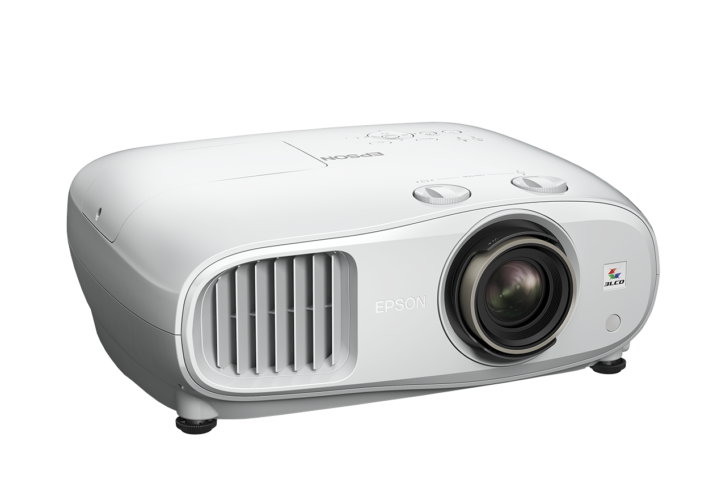
The screen arrived in a 12-foot long box weighing just under 75-pounds, making me a tad concerned how I was going to deal with this beast on my own. Fortunately, it comes completely pre-built, and Elite Screens could not make the install process any simpler, providing all of the dimensional drawings needed as well as offering a few mounting options.
Two bracket connectors come pre-installed in the top of the screen that you can slide around to position as needed. I took a couple of measurements, determined screen center, drilled some pilot holes into the framing in my soffit, slid the brackets where they needed to go, and secured the two M5 eyebolts included with screen. For under $3 at Lowe’s, I bought a couple of stainless-steel eyebolts that screwed into my soffit, and with my wife’s assistance, we suspended and quickly secured the screen click-click with the provided carabiners. I threw a long level on top of the screen, tweaked the bolts a bit until it was level, and done. Total install time: about 30 minutes.
A power cord hangs from the left side of the case, and once powered on I pressed the down button on the included RF remote and the screen quietly lowered into place. I gotta say, you can’t help but feel a surge of excitement when you see that 135-inch screen lower for the first time, knowing you’ll be watching movies outside on a larger screen than most people have inside.
Visually, the screen is nice looking. When retracted, the case has a fairly low-profile rounded design with a black color that doesn’t call attention to itself. When lowered, there are 12-inches of black drop at the top, along with 2.5-inches of black masking around the sides and bottom helping with overscan and perceived contrast. If you don’t want the full 12 inches of drop, you can set a limit to have the screen automatically stop shorter. The tensioning cords along the sides keep the screen nice, taut, flat, and stable when in use.
The screen comes with a magnetic bottom bar bracket that can be mounted to hold it in place to keep it from swaying in the wind. While these brackets are a great idea, they are designed to work when the screen is wall mounted, so I couldn’t use them in my install. In practice, I found the bottom bar weighty enough that the screen didn’t have any wind issues, however my install was kind of in a “protected” corner of my house, so your results will vary.
In addition to the RF remote, the screen includes a small wireless 12-volt trigger. This little device has a mini-jack connection that plugs into your projector, causing the screen to lower/raise automatically based on the projector’s status. Slick!
Even with a bright projector driving it, it still needs to be pretty dark outside to get a decent image, and you want it dark to get something really impressive. After dinner, I fired up the Epson and started dialing and squaring the image, and the screen came to life with huge, bigger-than-life images. Colors are bright and rich with whites having nice pop.
The dual-sided screen material definitely adds a bit of softness and diffusion to the image, keeping me from getting a razor-sharp focus. On the Draper M1300 screen inside my house, I could focus the Epson sharp enough to see individual pixels, but on the WraithVeil material, that level of focus and fine detail just wasn’t possible. Though, with outdoor seating distances likely further back than typical, this created a nice film-like image quality.
Want more stories like this delivered to your inbox every day? Then sign up for the free Residential Systems eNewsletter here.
In my installation, the screen hangs about a foot in front of a wall of my home painted a light beige color. With its dual-sided viewing properties, all the light blasting through the screen really lights up this light-colored wall behind the screen, which then reflects back onto the screen, knocking down contrast.
I found that with the reflection off the back wall, images actually looked better using the Eco light mode on the Epson instead of high brightness. Poking my head behind the screen revealed that the material is definitely working as intended, with the picture on the backside nearly as good as that on the front, though obviously reversed. Not really a problem with normal content, but something that would cause issues with any subtitles or info scrolls like an ESPN ticker.
The off-angle viewing is as good as advertised, and I could move off-center as far as anyone would be practically seated and still get a really enjoyable image.
While the Epson projector does feature dual 10-watt rear-firing speakers that actually do output sound — which you can Bluetooth audio to should you wish — in practice these speakers deliver mediocre sound at best, not really delivering much audio unless you are seated in close proximity to the unit. For outdoor theater sound, I connected my MSE Audio Cherry Bomb speakers and OS-440 amplifier (review available online) to the system and would highly recommend a separate audio system.
Nothing brings out the critters in your neighborhood like a giant beaming spotlight reflecting light off a 135-inch screen in an otherwise dark night, and having moths and other things flying around you and landing on the screen will likely be an issue. But, even still, there is something near magical about having your own drive-in theater experience outside as family and friends gather around to have a cinematic experience under the stars.
I think the ideal installation for this screen fabric would be with the screen hanging down from a Pergola-type structure with nothing behind the screen to reflect the light passing through. This would allow viewers on both sides to enjoy the image without any washout issues. Or – even better – you could use one of the new ultra-short throw projectors behind the screen firing towards viewers. For my install, I probably would have been better served by Elite Screen’s MaxWhite front projection material, which offers 1.1 gain and is also outdoor rated. However, they don’t currently offer that fabric option in the tensioned version.
Let’s get real — watching a movie/TV/sporting event outside isn’t about critical viewing. Between the bugs, ambient lighting of street lights, celestial bodies, and fire pits, viewers aren’t going to be nitpicking black levels or micro-detail. They are going to be marveling at the cinema-sized image as they laugh, cheer, and enjoy together. Outdoor theater is about bringing out some blankets, bowls of popcorn, and age-appropriate beverages and gathering to have a shared experience. And considering what this combo delivers for just over $3500, I’d say it is pretty near unbeatable.
562-483-8198 / ELITESCREENS.COM
Kudos: Terrifically simple installation; tensioning creates a really flat surface; wide viewing cone; RF/trigger control
Concerns: Screen material softens image; mounting near a wall reduces contrast; critters
Product Specs:
- Electric, tab-tensioned projection screen designed for outdoor use
- IP33-rated screen resists moisture, and mildew
- .8 gain with 150-degree viewing angle
- WraithVeil Dual material is bi-directional for front or rear projection applications
- Available in four sizes: 100-, 120-, 135-, 150-inches diagonal, 16×9 aspect ratio
